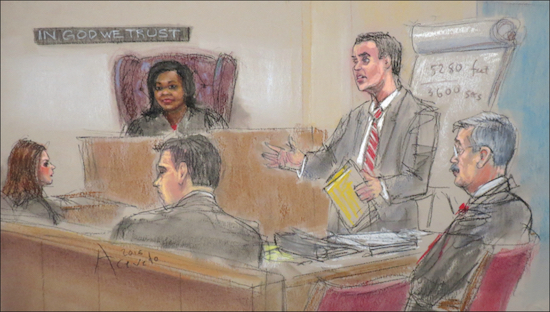SKETCHES OF COURT: Car-bus accident results in tangled series of claims

In this courtroom sketch, Hon. Genine Edwards listens as attorney Charles Liebman (standing) of the law firm Johnson Liebman makes his closing arguments to the jury in the motor vehicle accident trial Negron v. Boro Wide Buses. Court reporter Jean Marie Episcopia (far left) recorded the proceedings.
In January of 2011, a collision involving a car and a school bus occurred near the intersection of Bergen Street and Stone Avenue. Emily Kimble was behind the wheel of her car, approaching a corner regulated by a stop sign. The sun was low and glaring, the weather was freezing cold and the roads were icy from snow that had come down days earlier. Kimble lost control of her car and skidded into a school bus, which flipped onto its side in the impact.
Kimble was represented by Rosario M. D’Apice (seated, right), trial counsel to the law firm Cheven Keely & Hatzis.
Plaintiff Nelly Negron was a bus matron, and was not wearing a seat belt at the time of the accident in order to attend to the children in her care. She claimed serious injury in the collision. She was represented by James M. Marino (seated, left) of the law firm Raskin & Kremins.
Samuel Paul was driving the Boro Wide school bus down Stone Avenue. Traffic on Stone is unregulated at the intersection with Bergen Street. He was represented by Liebman.
At issue was the determination of liability. D’Apice claimed that his client did all she could under the conditions in which she lost control of her vehicle. He further argued that the bus driver was also negligent, and that given Paul’s experience and familiarity with the route and the prevailing road conditions, he should have anticipated the possibility of an accident and taken steps to avoid it.
The jury determined that the co-defendants were negligent, but that Boro Wide’s negligence was not a substantial factor in causing the accident, and that only Kimble’s negligence was a proximate cause. D’Apice tendered the entire policy proceeds, which were accepted in settlement subject to certain conditions.

Brooklyn Boro
View MoreNew York City’s most populous borough, Brooklyn, is home to nearly 2.6 million residents. If Brooklyn were an independent city it would be the fourth largest city in the United States. While Brooklyn has become the epitome of ‘cool and hip’ in recent years, for those that were born here, raised families here and improved communities over the years, Brooklyn has never been ‘uncool’.